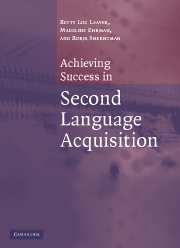Book contents
- Frontmatter
- Contents
- Notes on authors
- Acknowledgments
- Note to the reader
- Part I Learning
- 1 Planning foreign-language study
- 2 Understanding the role of cognition in the learning process
- 3 Learning styles and learning strategies
- 4 Understanding feelings and personality in language learning
- 5 Interpersonal dynamics in the learning process
- Part II Language
- Part III Independence
- Epilogue: from here to there: attaining near-native proficiency
- Appendix A Answers to “practicing what you have learned”
- Appendix B Learning strategies taxonomies
- References
- Index
3 - Learning styles and learning strategies
Published online by Cambridge University Press: 12 November 2009
- Frontmatter
- Contents
- Notes on authors
- Acknowledgments
- Note to the reader
- Part I Learning
- 1 Planning foreign-language study
- 2 Understanding the role of cognition in the learning process
- 3 Learning styles and learning strategies
- 4 Understanding feelings and personality in language learning
- 5 Interpersonal dynamics in the learning process
- Part II Language
- Part III Independence
- Epilogue: from here to there: attaining near-native proficiency
- Appendix A Answers to “practicing what you have learned”
- Appendix B Learning strategies taxonomies
- References
- Index
Summary
Preview
This chapter introduces you to the concepts of learning styles and learning strategies. These are important concepts that we will refer to throughout this book and have, in fact, made allusion to in chapters 1 and 2. Learning styles and learning strategies affect the nature and quality of learning, whether or not the learner knows anything about these concepts or not. Therefore, it is better to have an understanding of them, so that you can consciously use this information to good advantage. Topics in this chapter include:
Definitions of learning styles and learning strategies.
Learning styles. Learning styles are habitual patterns of perceiving, processing, or reacting to information.
Learning strategies. Learning strategies are the specific actions one takes and/or techniques one uses in order to learn.
Kinds of learning styles. This chapter divides learning styles into the following categories:
Sensory preferences. Sensory preferences refer to the channels through which we perceive information which consist of visual, auditory, and motor modalities, as a minimum.
Cognitive styles. Cognitive styles refer to individualized ways of processing of information. Many models of cognitive styles have been proposed. This chapter presents the E&L Construct in detail; this particular model organizes most of the work on cognitive styles into one system of cognitive profiles.
Personality types. These are another kind of learning style. Since they involve affective (emotional) factors, they are discussed in chapter 4, along with other affective variables.
Learning strategies. In addition to memory strategies, which were discussed in chapter 2, and communication strategies, which will be discussed in chapter 10, there are comprehension strategies and production strategies. This part of the chapter is divided into the following subtopics:
- Type
- Chapter
- Information
- Achieving Success in Second Language Acquisition , pp. 65 - 91Publisher: Cambridge University PressPrint publication year: 2005
- 2
- Cited by



